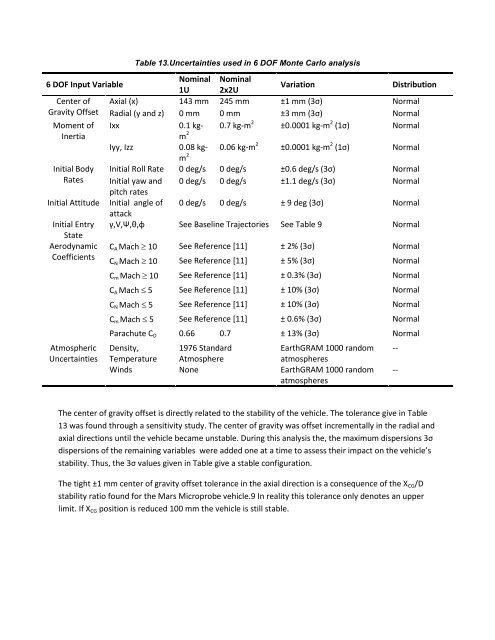SPORE Mission Design - Georgia Tech SSDL - Georgia Institute of ...
SPORE Mission Design - Georgia Tech SSDL - Georgia Institute of ...
SPORE Mission Design - Georgia Tech SSDL - Georgia Institute of ...
You also want an ePaper? Increase the reach of your titles
YUMPU automatically turns print PDFs into web optimized ePapers that Google loves.
Table 13.Uncertainties used in 6 DOF Monte Carlo analysis<br />
6 DOF Input Variable<br />
Nominal Nominal<br />
1U 2x2U<br />
Variation<br />
Distribution<br />
Center <strong>of</strong> Axial (x) 143 mm 245 mm ±1 mm (3σ) Normal<br />
Gravity Offset Radial (y and z) 0 mm 0 mm ±3 mm (3σ) Normal<br />
Moment <strong>of</strong> Ixx<br />
0.1 kgm<br />
0.7 kg-m 2 ±0.0001 kg-m 2 (1σ) Normal<br />
Inertia<br />
2<br />
Iyy, Izz<br />
0.08 kgm<br />
0.06 kg-m 2 ±0.0001 kg-m 2 (1σ) Normal<br />
2<br />
Initial Body Initial Roll Rate 0 deg/s 0 deg/s ±0.6 deg/s (3σ) Normal<br />
Rates Initial yaw and 0 deg/s 0 deg/s ±1.1 deg/s (3σ) Normal<br />
pitch rates<br />
Initial Attitude Initial angle <strong>of</strong> 0 deg/s 0 deg/s ± 9 deg (3σ) Normal<br />
attack<br />
Initial Entry γ,V,Ψ,θ,φ See Baseline Trajectories See Table 9 Normal<br />
State<br />
Aerodynamic C A Mach 10 See Reference [11] ± 2% (3σ) Normal<br />
Coefficients<br />
C N Mach 10 See Reference [11] ± 5% (3σ) Normal<br />
Atmospheric<br />
Uncertainties<br />
C m Mach 10 See Reference [11] ± 0.3% (3σ) Normal<br />
C A Mach 5 See Reference [11] ± 10% (3σ) Normal<br />
C N Mach 5 See Reference [11] ± 10% (3σ) Normal<br />
C m Mach 5 See Reference [11] ± 0.6% (3σ) Normal<br />
Parachute C D 0.66 0.7 ± 13% (3σ) Normal<br />
Density,<br />
Temperature<br />
1976 Standard<br />
Atmosphere<br />
EarthGRAM 1000 random<br />
atmospheres<br />
Winds None EarthGRAM 1000 random<br />
atmospheres<br />
--<br />
--<br />
The center <strong>of</strong> gravity <strong>of</strong>fset is directly related to the stability <strong>of</strong> the vehicle. The tolerance give in Table<br />
13 was found through a sensitivity study. The center <strong>of</strong> gravity was <strong>of</strong>fset incrementally in the radial and<br />
axial directions until the vehicle became unstable. During this analysis the, the maximum dispersions 3σ<br />
dispersions <strong>of</strong> the remaining variables were added one at a time to assess their impact on the vehicle’s<br />
stability. Thus, the 3σ values given in Table give a stable configuration.<br />
The tight ±1 mm center <strong>of</strong> gravity <strong>of</strong>fset tolerance in the axial direction is a consequence <strong>of</strong> the X CG /D<br />
stability ratio found for the Mars Microprobe vehicle.9 In reality this tolerance only denotes an upper<br />
limit. If X CG position is reduced 100 mm the vehicle is still stable.
















